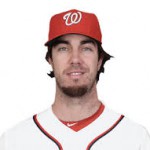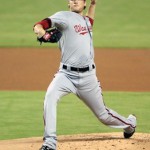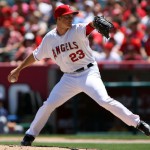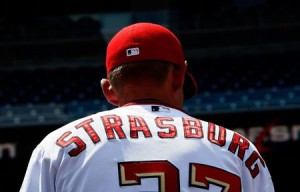The Nats management waited and waited, but finally gave in and dealt with season-long performance issues in Henry Rodriguez, Zach Duke, Danny Espinosa and Tyler Moore in the first two weeks of June, DFA-ing or demoting as needed and bringing in replacements to try to do a better job and turn this season around.
So, when will it be time to talk about the train-wreck season that Dan Haren is having? For $13M, here’s what the team has gotten in his first 12 starts, including June 12th’s meltdown:
- a 4-8 Record with a 5.70 ERA and a 67 ERA+ (his ERA is 6th worst in baseball for qualified pitchers).
- A 6-10 team record in games in which he’s started
- a league leading 17 home runs allowed
A quick glance at his advanced stats doesn’t give much credence to any apologists that may try to excuse his line either; his BABIP is slightly elevated but not overly so (.320) and his FIP is still an unsightly 5.06 (5th worst among qualified starters). Only his expected xFIP and SIERA numbers are relatively respectable, but xFip is just an estimator stat and often times never comes to pass, since it assumes silly things like the fact that Haren can’t possibly keep giving up this many home runs… an assumption that continued to be disproven as he gave up two more in his most recent loss in Colorado.
Game-Log analysis: Haren has yet to have a start where he shut out the opponent. He’s only got 5 quality starts out of 12. In half his starts he’s allowed 4 or more runs (not good when your team’s offense is only scoring 3.4 runs a game). Haren’s only really had a couple of starts that were “grade A” in my book (his best start of the year was an 8 inning 4 hit performance in Atlanta of all places). In his defense, he has gotten awful run support (2.84 runs per start), heavily indicating team losses every time he pitches.
I’ll admit it; I talked myself into the Haren deal big time after it was announced. I ignored his 2012 struggles, looked back to the near Cy Young guy he was in 2009 and thought this was the move that could push the Nats to a 105 win team. Now clearly whatever excuses we made for his performance in 2012 (back injury leading to diminished velocity leading to loss of his sinker leading to crummy numbers) seem like they’re covering up for an aging sinkerballer who never had lights out velocity and who now looks dangerously close to extinct as his very-hittable fastball flattens out and gets hit harder and harder.
So what’s the answer here?
Don’t talk to me about his salary; that $13M is out the door already. Kaput. Gone. Look up the definition of a “Sunk Cost” in economic terms. If you were worried about $13M in annual salary then you shouldn’t have bought a $15M a year closer who isn’t exactly a complete shutdown guy (Tyler Clippard has almost identical stats this year to Rafael Soriano for a third of the price and he didn’t cost us a 1st round draft pick, which as it turned out could have been spent on one of two pre-draft top-10 talents). The decision needs to be made; do you still want to try to “win now” in 2013 as all the other off-season moves seemed to indicate? Because the solution likely is going to be a bit more money and a few more prospects.
Short term (as in, the next week): see how Ross Ohlendorf does in his spot start (Answer: uh, he did awesome, holding a good hitting team to two hits through 6 in the best hitters park in the league). If he’s anything remotely close to effective, I think you look at an invented D/L trip for Haren and send him on a rehab assignment tour of the minors.
Mid-term (as in, for the next couple weeks): do we have anyone else in the minors worth checking out? Not on the 40-man and not with enough experience. Maybe we give Danny Rosenbaum a shot if another spot-start is needed after Detwiler and Strasburg come back.
Longer term (as in, the next two months); Look at the trade market and look at who may be available leading up to the trade deadline. We’re already seeing some teams completely out of it and clearly some guys will be available:
- The Cubs probably will look to move Scott Feldman and especially Matt Garza.
- The Astros probably will cash in on Lucas Harrell and Bud Norris (nobody’s likely interested in Erik Bedard at this point).
- The Marlins would listen for offers for Ricky Nolasco, though perhaps not intra-division.
- The Mets aren’t winning this year and could be moving Shawn Marcum (though perhaps not intra-division).
- I think eventually Seattle becomes a seller: Joe Saunders and Aaron Harang should be dangled.
- I also think San Diego eventually realizes they’re not going to win the NL West: Edinson Volquez, waiver pickup Eric Stults, Clayton Richards and our old friend Jason Marquis all make for possible trade candidates.
A few other poorly performing teams are probably going to be too stubborn to wave the white flag, which cuts down on the number of guys that will be available (see the Los Angeles Angels, the Los Angeles Dodgers, Toronto specifically).
The only problem with a trade market move is this: all these teams are going to want prospects back. And the Nats prospect cupboard has been cleaned out recently to acquire all these fools who are underperforming so far in 2013. I’m not an opposing GM, so I can’t say for sure, but from a quick look at the Nats best prospects in the minors right now (basically in order: Giolito, Goodwin, Cole, Karns, Garcia, Skole, Purke, Solis, Perez, then guys like Hood, Taylor, Walters, Ray and Jordan round out the list) and I see a lot of injured guys or players on injury rehab, backups or guys barely above or still in A-ball. I’m not trading a valued asset for an injury-risk guy who has never gotten above AA. Who on this list is going to fetch us a quality major league starter?
Maybe we trade Haren along with a huge chunk of his remaining salary and multiple prospects to one of these teams in order to get one of these 5th starters back. But that’d be an awful trade when it was all said and done (about as awful as, say, the Giants trading Zack Wheeler to the Mets for 2 months of Carlos Beltran in a failed effort to make the playoffs in 2012; with all the Giants 2013 pitching issues do you think they wish they had Wheeler back right now??)
Or, it very well may be that the Nats are stuck; we knew going into the season we had no starter depth and those MLFAs we did acquire (Ohlendorf and Chris Young basically) probably aren’t the answer. But something has to give; we can’t give away every 5th start like we seem to be doing now and claw back into the NL East race.



